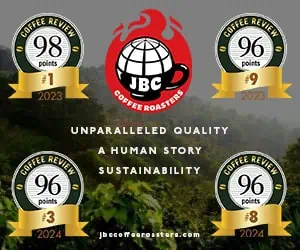I’ve just finished washing the cups and brushing out the grinder after cupping about 180 coffees (including 35 or so espressos) from twenty distinguished American specialty roaster-retailers.
The reason for all the cupping is explained elsewhere in this issue. It seems worthwhile, however, to report on a little of what I learned (or think I learned) during my marathon cupping. (The twelve coffees described here are a selection from among the approximately 150 non-espresso coffees submitted from the twenty roasters. The results of my tasting of the espressos will appear later this fall.)
It’s important not to view the twelve coffees described here as the “best” of anything, just a selection of the very good coffees of mid-1998. So far, the staff at Coffee Review has requested coffees from only about twenty or so roasters. Many fine coffees from many excellent roasters haven’t made it to my little cupping room. Given the richness of the American specialty coffee industry 150 coffees is a mere dribble in the demitasse.
More significantly, coffees change. New shipments come in, old shipments go out. Roastmasters also come and go, as well as occasionally space out when they should be paying attention to the roast. A coffee that appears in the same bag a year from now is not the same coffee that filled that bag this year.
I find myself constantly reiterating that coffee is a continual, trans-oceanic work-in-progress, a massive cross-cultural collaboration of people who usually don’t even know one-another’s names: grower, processor, exporter, importer, coffee buyer, roaster, and finally customer who grinds and brews the roasted beans.
Every crop year is different, every lot of coffee is different. To some degree, every batch of coffee that tumbles from the roaster is different. Everyone along the line from grower to roaster strives for consistency, but coffee is fascinating precisely because it is an extremely complex collaboration between human beings and nature, and nature has a way of frustrating consistency_in ways that both inspire and perplex us.
This changeability was highlighted by two instances in this cupping. In one, the latest incarnation of a single-origin coffee I had given a very high rating to in an earlier cupping turned out to be very disappointing this time around. Apparently the original lot of this particular coffee had run out and the roaster started selling an inferior version (perhaps the best he could find) in the same bag.
The second instance had a happier ending. A roaster whose coffees were rather carelessly roasted a year ago (the roast seemed rushed and the coffees tasted either flat or burned) turned things around completely. His coffees this time around were paragons of tactful, attentive roasting, achieved apparently after a deliberate campaign of study and consultation.











